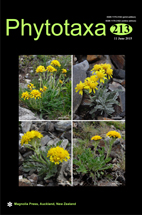Abstract
Senecio carniolicus (Asteraceae) is an intricate polyploid complex distributed in the European Alps (di-, tetra- and hexaploids) and Carpathians (hexaploids only). Molecular genetic, ecological, and crossing data allowed four evolutionary groups within S. carniolicus to be identified. Here, we establish that these four groups (two vicariant diploid lineages, tetraploids and hexaploids) are also morphologically differentiated. As a consequence, we draw taxonomic conclusions by characterizing four species, including the more narrowly circumscribed S. carniolicus (lectotypified here), the taxonomically elevated S. insubricus comb. nov. (lectotypified here), and the two newly described species S. disjunctus and S. noricus.

